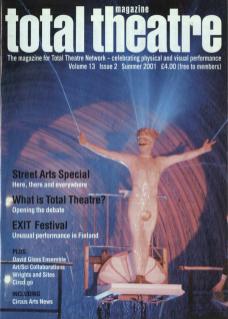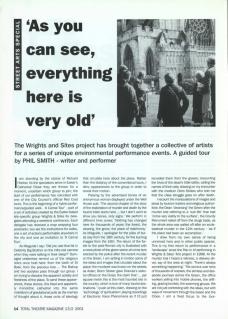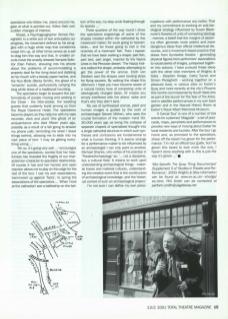I am standing by the statue of Richard Hooker. As the spectators arrive in Exeter's Cathedral Close they are thrown for a moment, uncertain which group to join; the start of our performance has coincided with one of the City Council's official Red Coat tours. This is the beginning of a hybrid performance/guided walk – A Carnal Tour – part of a set of activities created by the Exeter-based site-specific group Wrights & Sites for delegates attending a weekend conference. Each delegate has received a map wrapping four postcards; two are the instructions for walks, one a set of actions performable anywhere in the city, and one an invitation to ‘A Carnal Tour'.
As Misguide I say: 'Did you see that bit in Celebrity Big Brother on the infra-red camera when they were talking in their sleep?' Damaged celebrities remind us of the religious relics once held here: from the tooth of St Basil, from the precious tree... The Bishop and two acolytes pass through our group. I am trying to dissolve the apparent solidity and fixedness of the place. To send these appearances, these stones, this fixed and apparently monolithic cathedral into the same maelstrom of gravitational pulls as the memes of thought about it, those units of ideology that circulate here about the place. Rather than the blatancy of the conventional tours, I deny appearances to the group in order to reveal their motion.
Passing by the advertised bones of an anonymous woman displayed under the Well House pub: 'The second chapter of the story of the exploitation of murder and death by the tourist trade starts here... but I don't want to show you bones, only signs.’ We perform in different time zones: 'Nothing has changed here for thousands of years; the forest, the clearing, the grove, the place of matrimony.' As Misguide, I apologise for the piles of burial clay from the 18th century, for the burning images from the 16th. The return of the forest to the post-Roman city is illustrated with a news photo of the green scene-of-crime tent erected by the police after the recent murder on the Green. I am setting in motion some of the ideas and images that circulate about the place: the murderer was known on the streets as Aslan; Bram Stoker gave Dracula's solicitor offices on the Close; the claim that ‘... per square metre this is the most haunted site in the country, which is true of many tourist destinations’. I push at this claim, drawing on the technology of spiritualism – playing recordings of Electronic Voice Phenomena as if I'd just recorded them from the graves; recounting the trivia of the dead's tittle-tattle; calling the names of their cats; drawing on my encounter with the medium Doris Stokes who told me that the class struggle goes on after death.
I recount the manipulations of images and ideas by tourism traders and religious authorities: the Dean 'cleansing’ the Green after the murder and referring to a 'sub life that had come very visibly to the surface', the County Monument railed off from the drugs trade, as the whole area was walled off after an ecclesiastical murder in the 12th century – 'as if the place had been an accomplice'.
I draw from my own sense of being unnerved here and in other public spaces. This is my first return to performance in a ‘landscape' since the panic of performing in Wrights & Sites' first project in 1998. At the murder trial I heard a witness, a delivery driver, say of the area at night: 'There's always something happening.’ The picnics over tens of thousands of corpses, the aimless and desperate journeys across the Green, the office workers yelling into mobile phones, the drifting, grazing tourists, the swimming groups. We are not just contesting with the ideas, but with ways of movement through the Green and the Close. I am a fixed focus to the tour spectators who follow me, stand around me, gaze at what is pointed out, follow their own sudden changes of interest.
Ahead, a Psychogeographer (Simon Persighetti) in a white suit of text anticipates our progress, his movement defined by his struggles with a huge white map that sometimes wraps him up, at other times serves as a sail to drag him this way and that. In smaller circuits move the smartly dressed Vampire Solicitor (Dan Fisher), shouting into his phone about the problems of accommodating a property deal for the living dead and dabbing at his mouth with a bloody paper hankie, and the Nun-Bride (Becky Smith), the ghost of a ‘romantic' suicide, perfunctorily carrying the long white dress of a traditional haunting.
The spectators begin to suspect the performativity of people moving and working in the Close – the litter-picker, the wedding guests that suddenly burst among us from the Royal Clarence Hotel. The spectators become players as they help me with my tape recorder, stick and plant (the ghost of an acquaintance who died fifteen years ago, possibly as a result of a fall going to answer my phone call); reminding me when I leave things behind, allowing me to elide into my next piece of text: 'I may be getting everything wrong...'
‘Oh no, it's going very well...' encourages one of the spectators, worried that her helpfulness has revealed the fragility of our character/non-character-to-spectator relationship. Of course it has and her honest and open reaction allows me to play on this edge for the rest of the tour. I use my own associations, hammered up against 'facts', to spring the associations of the spectators... When I look at the cathedral I see a battleship on the bottom of the sea, my step-uncle floating through its spaces...
Three quarters of the way round I show the spectators engravings of some of the shapes created within the cathedral by the misericord maker, for souls going to heaven: birds... and for those going to hell in the clutches of a mermaid: fish. Then I explain that we have been walking a shape: part fish, part bird, part angel, inspired by the Nazca Lines in the Peruvian desert: The Nazca Indians walked the shape, probably attempting to get the power of the animal. Erich von Däniken said the shapes were landing strips for flying saucers. By walking the shape this afternoon I hope you have become aware of a natural history here of competing units of ideologically charged ideas. Or maybe you simply interfered with the aliens radar and that's why they didn't land.
My use of synthesised animal, plant and human images is guided by the work of archaeologist Steven Mithen, who sees the crucial formation of the modern mind 50-30,000 years ago as being the collapse of separate chapels of specialised thought into a single cathedral structure in which such syntheses and confusions are fundamental to what is human thinking. If it seems strange for a performance maker to be influenced by an archaeologist I can only point to another, Michael Shanks, who writes of his practise in Theatre/Archaeology as: ‘... not a discipline but a cultural field. It means to work upon understanding archaeological things – material traces and material cultures, understanding the creative event that is the construction of archaeological knowledge, and the historical context of such an archaeological project.’
I'm not sure I can define my own preoccupations with performance any better. That and my commitment to evolving an anti-ideological strategy influenced by Susan Blackmore's theories of units of competing ideology – memes; a belief that the margins of esoterica often generate more potent and more dangerous ideas than official intellectual discourse, and a movement-based practice that draws from Symbolist theatre – generating physical figures from performers' associations to vocabularies of images, juxtaposed together into actions. I have pursued these ideas with the other core members of Wrights & Sites – Stephen Hodge, Cathy Turner and Simon Persighetti – working together on a pleasure boat, in various sites on Exeter's Quay, and more recently at the city's Phoenix Arts Centre commissioned by South West Arts as part of the launch for The Year of The Artist, and in satellite performances in my own back garden and in the Natural History Room at Exeter's Royal Albert Memorial Museum.
A Carnal Tour is one of a number of trial events for a planned 'Misguide' – a set of postcards, maps, pamphlets and performances to provoke new ways of moving about Exeter for local residents and tourists. After the tour I go home and, as promised to the spectators, shave off the beard I've grown for the performance: ‘I'm not an official tour guide, but I've grown this beard to look more like one, haven't done anything with it, this is just the way it's grown...’
Wrights & Sites Information can be found at: www.ex.ac.uk/-shodge/ ws.html.


